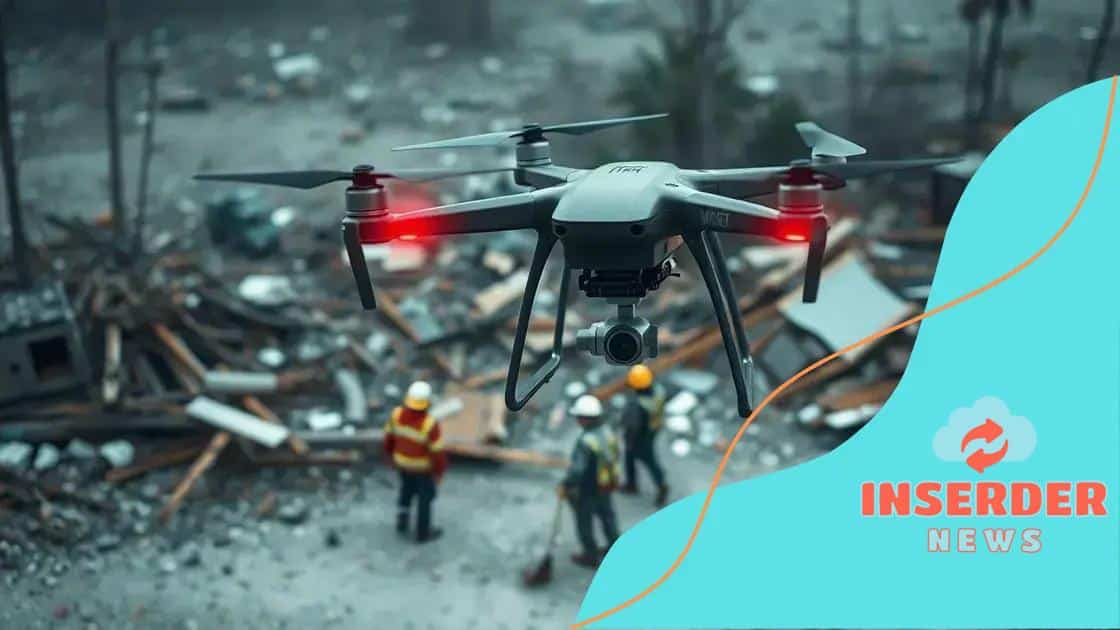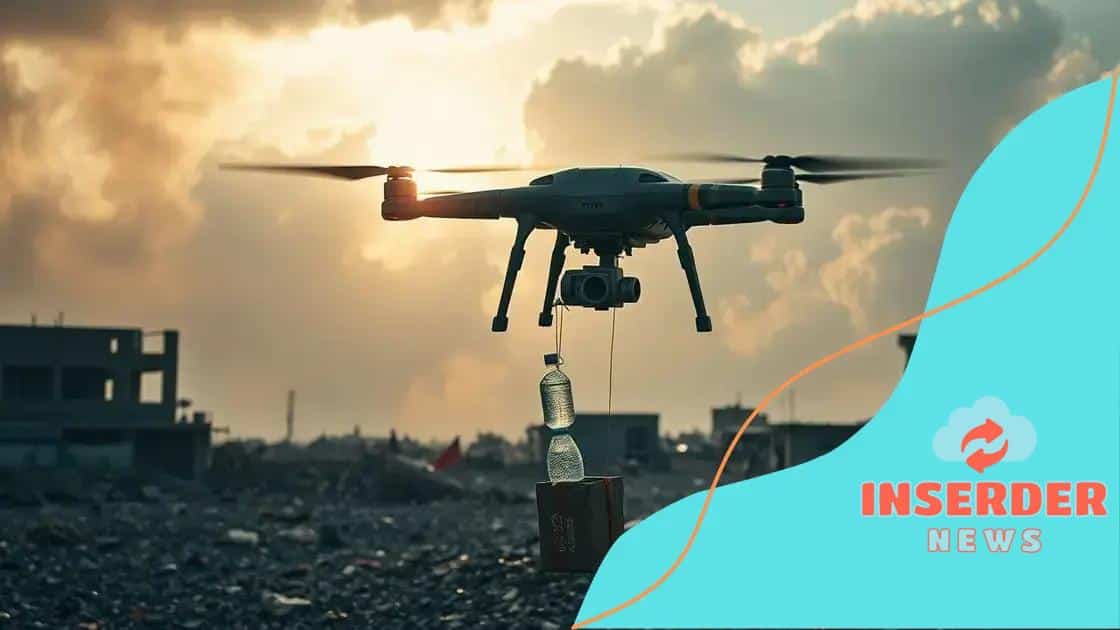How drones are being used for disaster recovery

How drones are being used for disaster recovery includes assisting in search and rescue operations, delivering essential supplies, mapping affected areas, and overcoming challenges like regulatory restrictions and technical limitations.
How drones are being used for disaster recovery is reshaping rescue operations after catastrophes. Have you ever wondered how these flying devices can help save lives? In this article, we’ll delve into the transformative impact of drones during disasters.
The role of drones in initial assessments
During the crucial moments after a disaster, understanding the extent of damage is essential. The role of drones in initial assessments has revolutionized how we gather information quickly and efficiently. These flying devices provide real-time data that is invaluable for emergency responders.
Benefits of Using Drones
When deployed immediately, drones can access areas that are otherwise dangerous or impossible to reach. With high-resolution cameras and thermal imaging, they offer detailed views of the affected regions. As a result, this technology allows teams to prioritize rescue efforts effectively.
- Rapid data collection from inaccessible locations.
- High-resolution imaging for damage assessment.
- Thermal imaging to locate survivors.
- Cost-effective solution for initial evaluations.
The ability to fly over hazardous terrains ensures that no time is wasted in identifying areas needing urgent attention. Imagine a drone surveying a collapsed building, capturing images that pinpoint where people might still be trapped. This capability provides critical insights that guide the actions of rescue teams.
Types of Drones Used
Different types of drones serve unique purposes during assessments. For example, quadcopters are popular for their maneuverability in tight spaces. Fixed-wing drones can offer longer flight times, which is useful for covering vast areas quickly. By selecting the right type of drone for the job, rescue operations can maximize efficiency and effectiveness.
- Quadcopter drones for detailed inspections.
- Fixed-wing drones for larger area coverage.
- Multi-rotor drones for versatility in urban environments.
As advancements in drone technology continue, their use in initial assessments is likely to grow. The potential this technology holds for improving emergency response is significant and can make a difference between life and death. By leveraging drones, communities can not only respond faster but also save more lives in the process.
Mapping disaster areas with drone technology
Mapping disaster areas with drone technology provides critical information that can aid in recovery efforts. Drones have proven to be vital tools for capturing aerial views and generating accurate maps of affected regions. This process begins soon after a disaster strikes, facilitating timely decision-making.
How Drones Create Maps
Drones equipped with advanced sensors and cameras can quickly survey large areas. They capture high-resolution images that are later processed to create detailed maps. These maps show the extent of damage, helping responders understand where to focus their efforts. The mapping process typically involves using software that stitches together images into comprehensive layouts.
- High-resolution imagery for precise mapping.
- Geographic information systems (GIS) for analysis.
- Real-time data collection to update maps continuously.
Using drone technology, teams can produce three-dimensional models of the disaster area. This enables planners to visualize the terrain and make more informed decisions about rescue and recovery missions. For instance, a drone can fly over a flood-affected area and provide live images that reveal accessible routes and obstacles.
Advantages of Drone Mapping
The efficiency of using drones over traditional mapping methods cannot be overstated. Drones can cover vast stretches of land in a fraction of the time it would take ground crews. This speed is essential during emergencies when every minute counts. Furthermore, drones can access hazardous areas that might pose risks to human life.
- Faster data collection that saves time.
- Access to hard-to-reach locations.
- Cost-effective compared to manned aircraft.
As technology evolves, the methods for mapping disaster areas will only become more sophisticated. The integration of machine learning and artificial intelligence with drone technology promises to enhance the accuracy of maps even further. Stakeholders can expect mapping to play an integral role in post-disaster recovery and rebuilding efforts, ensuring communities can bounce back stronger than before.
Delivery of supplies using drones

The delivery of supplies using drones has emerged as a game-changing solution in disaster response. In critical situations, getting necessary supplies to affected areas without delay is crucial. Drones can quickly transport food, water, and medical supplies, making them an essential tool during emergencies.
How Drones Deliver Supplies
Drone delivery systems are designed to carry payloads effectively over varying distances. Equipped with GPS technology, drones navigate to their destination accurately. They often use automated flight paths, allowing for quick and efficient drop-offs directly to areas in need. This capability ensures that supplies reach those who require help most.
- Quick transport of urgent supplies.
- Access to remote or inaccessible locations.
- Reduced risk for ground transport during disasters.
During a natural disaster, roads can become impassable, making traditional delivery methods challenging. In such scenarios, drones can bypass obstructions and deliver critical resources. For example, after a hurricane, drones can carry food and clean drinking water to entire communities cut off from assistance.
Benefits of Drone Delivery
The advantages of using drones for supply delivery are significant. First, this method allows for rapid response times, which can be lifesaving. Drones are capable of functioning independently under difficult conditions, ensuring that essential items reach people quickly. Additionally, utilizing drones often reduces delivery costs, making it an economical solution for humanitarian efforts.
- Faster response times allow for immediate assistance.
- Cost-effective compared to traditional delivery methods.
- Can operate under adverse weather conditions.
As technology advances, the weight capacity and range of drones will continue to improve, enabling them to deliver even larger supplies. This innovation could drastically change how organizations respond to disasters, making drone delivery an indispensable part of emergency logistics.
Drones in search and rescue operations
Drones in search and rescue operations are proving to be a vital asset in emergency situations. When disasters strike, locating survivors quickly becomes a top priority. Drones can cover large areas in a fraction of the time it would take rescue teams on foot, making them an invaluable tool in these critical moments.
How Drones Aid Search and Rescue
Equipped with high-resolution cameras and thermal imaging technology, drones can detect signs of life even in challenging conditions. They provide real-time video feeds to rescue teams, allowing them to make informed decisions on where to search next. This capability is especially crucial in situations where survivors may be trapped under rubble or hidden in dense vegetation.
- Rapidly scan large areas for signs of life.
- Use thermal imaging to locate heat signatures.
- Provide live feeds to direct human rescuers effectively.
The integration of drone technology into rescue operations helps improve efficiency and effectiveness. For example, a drone can quickly fly over a disaster zone, identifying areas that may require immediate attention. This real-time assessment streamlines the rescue process, ensuring that teams can respond to urgent situations without delay.
Advantages of Using Drones in Search and Rescue
There are numerous advantages to employing drones in search and rescue efforts. First, they can access hard-to-reach areas where traditional vehicles cannot operate safely. Second, the data collected by drones can be processed using software to create 3D maps of the affected region, enhancing situational awareness for rescuers.
- Access to unsafe or difficult terrains.
- Detailed mapping capabilities for better planning.
- Reduced risk to human life during searches.
As the technology continues to evolve, the potential applications of drones in search and rescue will expand. Future advancements may lead to even more efficient systems, helping to save lives and facilitate quicker recoveries in disaster zones.
Challenges and limitations of drone usage
While drones offer substantial advantages in disaster recovery, there are also significant challenges and limitations of drone usage. Understanding these obstacles is crucial for effectively integrating drones into emergency response efforts.
Common Challenges Faced
One of the primary challenges is the regulatory environment. Drones must adhere to strict regulations to ensure safety. These rules can limit how and where drones can be used, affecting response times during critical situations. Additionally, drone operation requires skilled pilots. Training personnel to operate drones effectively takes time and resources, which can be in short supply during emergencies.
- Regulatory restrictions can delay operations.
- Need for trained operators to manage drones.
- Limited flight times due to battery constraints.
Some technical limitations also hinder drone effectiveness. Weather conditions play a significant role, as strong winds or rain can prevent drones from flying safely. Moreover, there are challenges regarding the payload capacity of drones. They can only carry limited weights, which restricts the amount of supplies they can transport in one trip.
Operational Limitations
In search and rescue operations, line-of-sight constraints prevent drones from flying over some areas. Once out of sight, maintaining control becomes difficult, increasing the risk of losing the drone. Signal interference from buildings or natural obstacles can disrupt the connection between the drone and the operator, leading to potential operational failures.
- Weather conditions can interrupt operations.
- Limited range due to line-of-sight requirements.
- Signal interference affecting communication.
As drone technology evolves, some of these challenges may be addressed. Future advancements could lead to better battery life, improved payload capacities, and more autonomous systems that reduce reliance on skilled operators. However, recognizing the current limitations is essential to enhancing the effective use of drones in disaster recovery efforts.
In conclusion, the use of drones in disaster recovery is a powerful tool that can make a significant impact. With their ability to assist in search and rescue operations, deliver supplies quickly, and provide accurate mapping, drones enhance the efficiency of emergency response. However, challenges such as regulatory limitations and technical issues remain. By continuing to evolve drone technology, we can better utilize these devices to save lives and improve relief efforts during disasters. Embracing advancements in drone capabilities will ensure that they remain a vital resource in times of need.
FAQ – Frequently Asked Questions about Drones in Disaster Recovery
How do drones assist in search and rescue operations?
Drones can quickly scan large areas to locate survivors, utilizing high-resolution cameras and thermal imaging to identify heat signatures.
What types of supplies can drones deliver during a disaster?
Drones can transport food, water, medical supplies, and even tools to areas that are difficult to reach by traditional means.
What are some challenges associated with using drones?
Challenges include regulatory restrictions, the need for trained operators, and limitations in payload capacity and battery life.
How can drone technology improve over time?
As technology advances, drones may gain better battery life, larger payload capacities, and improved autonomous navigation systems, making them more effective in emergencies.






